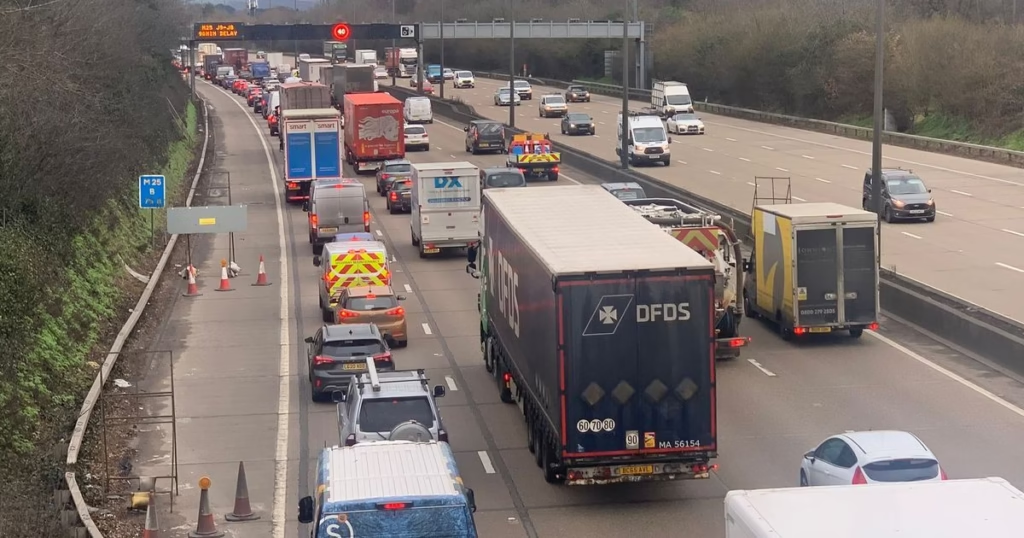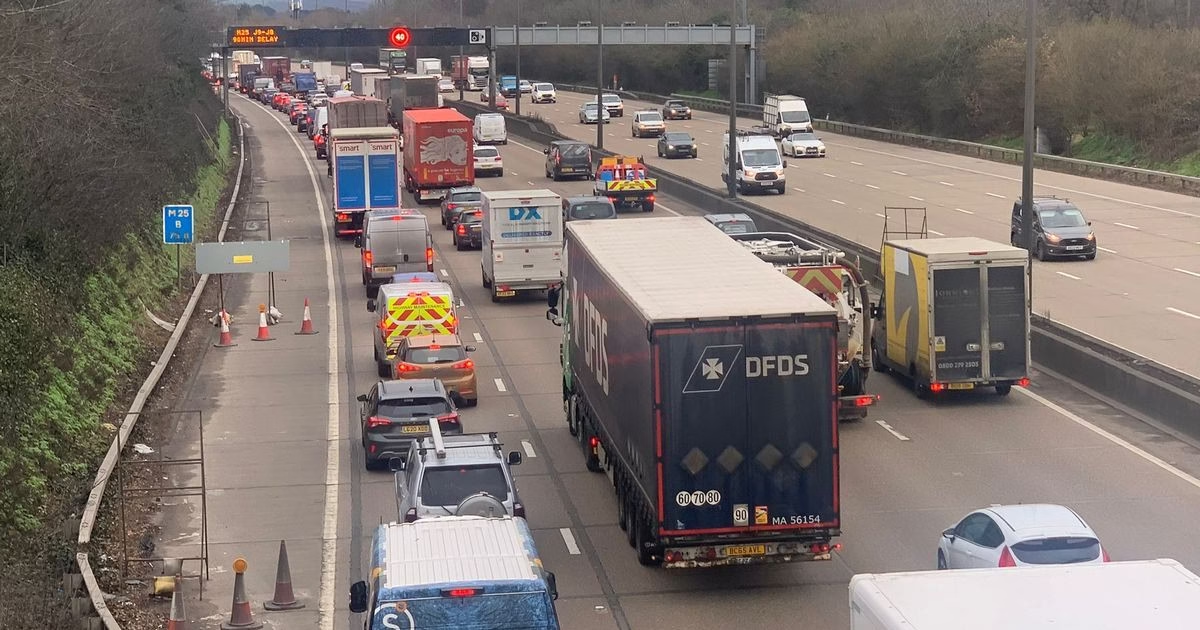
Why Is There So Much Traffic on M25
M25 traffic creates endless headaches for drivers every single day. Motorists repeatedly ask the same question: why is there so much traffic on the M25?
This motorway encircles London, handles millions of vehicles annually, and constantly struggles with accidents, breakdowns, and roadworks. At almost every junction, drivers face M25 delays, with traffic congestion frustrating commuters, hauliers, and holidaymakers alike.
In this blog, we break down the main causes of congestion, highlight the busiest spots, and share practical advice to help you handle traffic on the UK’s busiest motorway.
1. why the Sheer Volume of Vehicles on the M25
The M25 is London’s orbital motorway, linking key points such as Heathrow, Gatwick, the Dartford Crossing, and dozens of junctions that feed into regional and national routes.
Certain stretches handle more than 200,000 vehicles every day, making it one of the busiest motorways in Europe. With so many vehicles sharing the road, even a small slowdown can trigger long tailbacks that stretch for miles.
The motorway was never designed to cope with today’s traffic levels, which explains why congestion often feels unavoidable.
2. Why Frequent Roadworks
Ongoing M25 roadworks are a major contributor to delays. Crews frequently repair barriers, resurface lanes, and install new smart motorway technology.
While these improvements are necessary for long-term safety, they reduce capacity in the short term. Lane closures, speed restrictions, and narrow lanes increase journey times and fuel congestion—especially during peak hours.
3. Why Accidents and Breakdowns
Even minor incidents create ripple effects on the M25. A single breakdown in a live lane sparks queues that stretch for miles.
Emergency services, recovery vehicles, and cautious driving around the scene further reduce speeds. As a result, congestion often lasts far longer than the initial incident.
Given the motorway’s heavy mix of lorries, commuter traffic, and high speeds, accidents are frequent and disruptive.
4. Why Bottleneck Junctions
Some junctions are notorious for daily gridlock. The worst pinch points include:
- Junction 10 (A3 interchange) – One of the busiest and most complex junctions, undergoing a major upgrade.
- Junction 14 (Heathrow) – Heavy airport traffic fuels near-constant delays.
- Dartford Crossing (Junctions 1–2 and 30–31) – Tolls and merging lanes guarantee congestion.
- Junction 25 (A10 interchange) – A key commuter link that clogs heavily during rush hours.
These junctions are so busy that queues build even outside peak travel times.
5.why Weather Conditions
Heavy rain, fog, ice, and even strong winds can worsen driving conditions on the M25.
When visibility drops or road surfaces become slick, drivers naturally slow down. On a motorway already operating at near capacity, this chain reaction creates widespread traffic congestion, especially near Heathrow and the Dartford Crossing.
6. Why Driver Behaviour
Human behaviour adds to the problem. Poor lane discipline, sudden braking, tailgating, and “middle lane hogging” make congestion worse.
The M25 thrives on smooth flow. When drivers ignore rules or drive aggressively, they cause ripple effects that result in artificial bottlenecks and unnecessary slowdowns.
7. Seasonal and Event Traffic
Holidays, school breaks, football matches, and concerts near London put thousands of extra vehicles on the M25.
For example:
- Airport holiday surges add pressure around Heathrow and Gatwick.
- Wembley Stadium events cause traffic spikes on key approach routes.
These bursts of demand quickly overwhelm the motorway, forcing traffic to crawl at walking pace.
8. Lack of Alternatives
The M25 remains the main orbital route around London. Drivers have few alternatives that are both practical and fast.
While A-roads and regional bypasses exist, diverting traffic onto them only pushes congestion into towns and villages. For most long-distance journeys, the M25 remains unavoidable.
This lack of genuine alternatives is a key reason drivers constantly ask: why is there so much traffic on the M25?
How to Handle M25 Traffic
You cannot eliminate congestion, but you can manage it better with smart preparation.
1. Check Live Updates
Use live traffic updates from Google Maps, Waze, or National Highways before setting off. This helps you adjust routes and avoid hotspots.
2. Travel Off-Peak
Late mornings, early afternoons, and evenings after 7 PM usually flow better than traditional rush hours.
3. Plan Backup Routes
Keep alternatives in mind. Even if they take longer in distance, they may save you time compared to sitting in stationary queues.
4. Maintain Lane Discipline
Keep left unless overtaking, merge smoothly, and avoid sudden braking. Good driving behaviour improves traffic flow for everyone.
5. Be Prepared for Delays
Carry water, snacks, and chargers. If you get stuck in long queues, small comforts reduce stress.
Conclusion
M25 traffic feels unavoidable, but understanding its causes helps drivers plan better. High vehicle volumes, frequent roadworks, accidents, and bottleneck junctions all combine to create persistent M25 delays.
By checking live traffic updates, avoiding hotspots, and adjusting your travel times, you can reduce stress and reclaim valuable time on the road.
The motorway is unlikely to be congestion-free anytime soon, but smart planning makes the experience far more manageable.
FAQs
Q1: Why does the M25 always have traffic?
Because it carries massive vehicle volumes daily, combined with roadworks, accidents, and bottleneck junctions.
Q2: Which junctions are the worst for delays?
Junction 10 (A3), Junction 14 (Heathrow), Dartford Crossing, and Junction 25 (A10) consistently experience the longest M25 delays.
Q3: Do roadworks cause the majority of problems?
Yes, but they are not the only cause. Roadworks reduce lane capacity, but accidents and sheer vehicle numbers also play major roles.
Q4: How can I avoid M25 traffic?
Use live updates, plan journeys outside rush hours, and prepare backup routes before travelling.
Call to Action
Stay ahead of M25 traffic every day. For real-time updates, smart travel tips, and alternative route guidance, contact us today:
📧 Email: trafficupdates@youremail.com
📞 Phone: +44 1234 567890
Beat the congestion—drive smarter, not slower.
SEO Tags
- why is there so much traffic on M25
- M25 traffic
- M25 delays
- traffic congestion
- live traffic updates
- London motorway traffic
- Dartford Crossing traffic
- UK motorway
what is the m25 traffic like now
https://manyviral.com/can-trumps-big-beautiful-bill-pass-the-senate/
You might to like read this blog

Leave a Reply